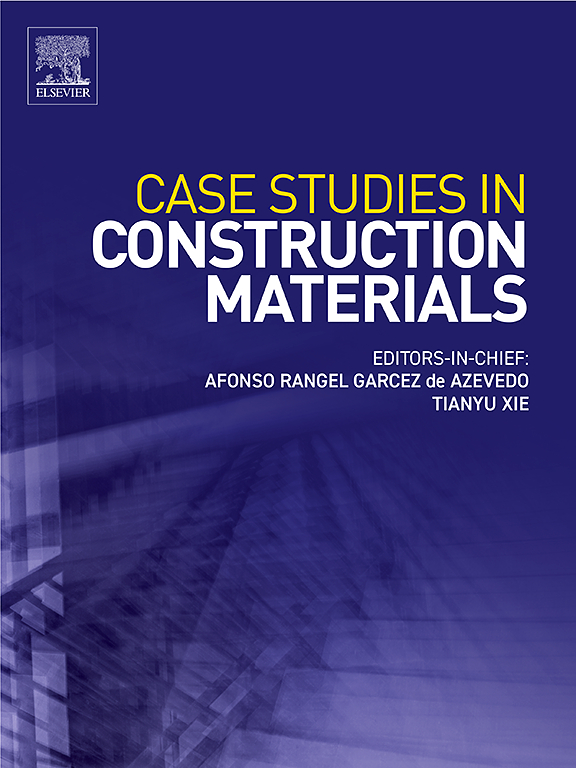聚丙烯纤维膨胀剂增强收缩补偿混凝土的力学性能及抗裂性能评价
IF 6.5
2区 工程技术
Q1 CONSTRUCTION & BUILDING TECHNOLOGY
引用次数: 0
摘要
混凝土侧壁在施工中起着至关重要的作用,但其在浇筑和养护过程中由于散热引起的变形控制是一个重大挑战。这通常会导致收缩和开裂等问题,这可能会损害侧壁的结构完整性和功能。为了克服这些问题,本研究旨在探讨在混凝土中添加膨胀剂(EXP)和聚丙烯纤维(PPF)以补偿收缩和抗裂的可行性。通过坍落度、抗压强度、抗弯强度、x射线衍射(XRD)、扫描电镜(SEM)等室内试验,分析了EXP和PPF混凝土的力学性能及抗裂机理。此外,还建造了一个全尺寸的混凝土侧壁,并实施了传感器监测,以测量温度、应力和应变变化。并对裂纹发展过程进行了数值模拟。结果表明,EXP降低了早期混凝土强度,但对最终强度的影响可以忽略不计。EXP和PPF均能提高混凝土的延性。确定混凝土的最佳配合比为9 % EXP和0.3 % PPF,具有理想的抗压和抗弯强度和足够的延性。对全尺寸侧壁的传感器监测表明,在养护过程中,内部温度变化可达40℃,表明EXP缓解了水化产生的热量,补偿了混凝土的收缩。全尺寸监测和数值模拟结果均证实EXP和PPF的联合使用增强了混凝土的延性,阻止了混凝土侧壁微裂缝的产生和扩展。本文章由计算机程序翻译,如有差异,请以英文原文为准。
Evaluation of mechanical properties and cracking resistance of shrinkage-compensating concrete reinforced by expansive agents with polypropylene fibers
Concrete sidewalls are crucial in construction, yet their deformation control during casting and curing due to heat dissipation is a significant challenge. This often leads to issues such as shrinkage and cracking, which can compromise the structural integrity and functionality of the sidewalls. To overcome these issues, this study aimed to investigate the feasibility of adding expansion agent (EXP) and polypropylene fiber (PPF) to concrete for shrinkage compensation and crack resistance. A series of laboratory tests, including slump, compressive strength, flexural strength, X-Ray diffraction (XRD), and scanning electron microscope (SEM) tests, were carried out to analyze the mechanical properties and cracking-resistance mechanism of EXP and PPF reinforced concrete. Furthermore, a full-scale concrete sidewall was constructed, and sensor monitoring was implemented to measure temperature, stress, and strain variations. Numerical simulation of crack developing process was also conducted. The results showed that EXP reduced the early-age concrete strength but had a negligible effect on the final strength. Both EXP and PPF enhanced the ductility of concrete. The optimal mix was identified as concrete with 9 % EXP and 0.3 % PPF, exhibiting desirable compressive and flexural strengths and adequate ductility. The sensor monitoring of the full-scale sidewall showed that the internal temperature variation could reach 40 °C during curing, indicating that EXP alleviated heat from hydration and compensated for concrete shrinkage. Both the full-scale monitoring and numerical simulation results confirmed that the combined use of EXP and PPF enhanced the ductility of concrete and prevented the generation and propagation of microcracks in the concrete sidewall.
求助全文
通过发布文献求助,成功后即可免费获取论文全文。
去求助
来源期刊

Case Studies in Construction Materials
Multiple-
CiteScore
7.60
自引率
19.40%
发文量
842
审稿时长
63 days
期刊介绍:
Case Studies in Construction Materials provides a forum for the rapid publication of short, structured Case Studies on construction materials. In addition, the journal also publishes related Short Communications, Full length research article and Comprehensive review papers (by invitation).
The journal will provide an essential compendium of case studies for practicing engineers, designers, researchers and other practitioners who are interested in all aspects construction materials. The journal will publish new and novel case studies, but will also provide a forum for the publication of high quality descriptions of classic construction material problems and solutions.
 求助内容:
求助内容: 应助结果提醒方式:
应助结果提醒方式:


